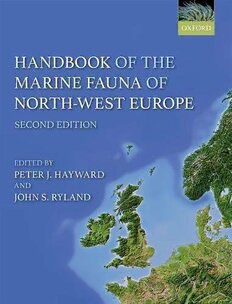
Handbook of the marine fauna of north-west europe PDF
Preview Handbook of the marine fauna of north-west europe
HANDBOOK OF THE MARINE FAUNA OF NORTH-WEST EUROPE H A N D B O O K O F T H E Marine Fauna of North-West Europe SECOND EDITION EDITED BY . PETER J HAYWARD . AND JOHN S RYLAND 1 3 GreatClarendonStreet,Oxford,OX26DP, UnitedKingdom OxfordUniversityPressisadepartmentoftheUniversityofOxford. ItfurtherstheUniversity’sobjectiveofexcellenceinresearch,scholarship, andeducationbypublishingworldwide.Oxfordisaregisteredtrademarkof OxfordUniversityPressintheUKandincertainothercountries ©OxfordUniversityPress2017 Themoralrightsoftheauthorshavebeenasserted FirstEditionpublishedin1995 SecondEditionpublishedin2017 Impression:1 Allrightsreserved.Nopartofthispublicationmaybereproduced,storedin aretrievalsystem,ortransmitted,inanyformorbyanymeans,withoutthe priorpermissioninwritingofOxfordUniversityPress,orasexpresslypermitted bylaw,bylicenceorundertermsagreedwiththeappropriatereprographics rightsorganization.Enquiriesconcerningreproductionoutsidethescopeofthe aboveshouldbesenttotheRightsDepartment,OxfordUniversityPress,atthe addressabove Youmustnotcirculatethisworkinanyotherform andyoumustimposethissameconditiononanyacquirer PublishedintheUnitedStatesofAmericabyOxfordUniversityPress 198MadisonAvenue,NewYork,NY10016,UnitedStatesofAmerica BritishLibraryCataloguinginPublicationData Dataavailable LibraryofCongressControlNumber:2016946646 ISBN 978–0–19–954944–3(hbk.) 978–0–19–954945–0(pbk.) DOI10.1093/acprof:oso/9780199549443.001.0001 PrintedinGreatBritainby CPIGroup(UK)Ltd,Croydon,CR04YY LinkstothirdpartywebsitesareprovidedbyOxfordingoodfaithand forinformationonly.Oxforddisclaimsanyresponsibilityforthematerials containedinanythirdpartywebsitereferencedinthiswork. PREFACE The first edition of the Handbook of the Marine Fauna of North-West Europe was published in 1995,anditisperhapsameasureofitsusefulnessthatithasbeenreprintedinalmosteveryyear since. It evolved from a two-volume predecessor, The Marine Fauna of the British Isles and North- West Europe (Clarendon Press, 1990), which had originated as a manual intended to aid the identification of the most familiar and widely distributed species of fish and benthic macrofauna of the coastal waters of Britain and Ireland, and the adjacent coasts of Europe. Prior to then, marine biologists,amateurandprofessional,hadperforcetorelyuponarangeoffieldguides,monographs, andspecialistpublicationsfortheidentificationofcoastalmarineanimals.TheHandbookwasamore compactwork,withfewerspeciesandratherlessdetailthanwasincludedinitsprogenitor,butitwas notsimplyanabridgement.Whilethetotalnumberofspeciestreatedwasreduced,asmallnumberof additionalspecieswasincluded,andrecenttaxonomicrevisionswereincorporated. The wider application of, in particular, molecular genetic techniques for the characterization of individual species has resulted in substantial changes in the understanding of the systematics and phylogeny of practically all marine animal groups. Phylogenetic analyses have revealed previously unsuspectedrelationships,demandingreappraisaloftraditionalclassificationsandinvolvingconsid- erablemodificationoftaxonomicnomenclature.Whilerelativelyfewentirelynewspeciesofmacro- fauna have been revealed, the marine communities of the north-west European shelf have changed. The sources of change are various. In a period of rising concern for the health of the natural environment,therehasbeenanincreaseintheextentofmonitoringandrecordingofmarinespecies andcommunities;oneconsequenceofthisisthatsomespeciesformerlyconsideredtobeuncommon, and infrequently encountered, are now seen to be quite widely distributed within the region. The application of more selective sampling techniques also allows the occurrence of delicate or deep- burrowing infaunal animals to be more accurately recorded. Anthropogenic disturbance is another significantsourceofchange;benthicfishinggear,anddredgesemployedinaggregateextraction,may result in the decline of some components of the benthic community, and the spread of others. Environmentalchangeisalsoasignificantfactordrivingchangeinthemarinebenthiccommunities of north-west Europe. The geographical distributions of, for example, south-western, warm-water species are spreading northwards as sea temperatures rise, while the ranges of northern, cold-water species may be expected to contract. Exotic, invasive species are an especially conspicuous new element in the marine fauna of north-west Europe, and the number of newly occurring species is likelytocontinuetoincrease,partlyasaconsequenceofseawaterwarming,butalsoasadirectresult of anthropogenic introductions, as part of the ship-borne fouling community, and as associates of translocatedoysterstock.Thespreadofsuchspeciesisfurtherfacilitatedbycoastalleisurecraftand thedevelopmentofmarinas,allowingstepping-stonedispersalthroughtheregion. The primary purpose of this book is to provide swift and simple identifications of the animal specieslikelytobeencounteredduringshore-basedandcoastalmarinefieldstudies,andduringthe vi PREFACE courseofinshoresurveyandmonitoringwork.Theselectionofanimalsincludedvariesbetweenthe differentgroups.Thecoverageofmolluscsanddecapodsisstillextensive,asthesetendtobeamong the ecologically more important components of the benthos and attract the eye more readily than hydroids, small worms, or copepods. Some groups requiring specialist techniques for collection, examination, and identification have been excluded entirely, for example, Protozoa, Pogonophora, and Tardigrada. The selection of fish is limited to intertidal and coastal species, as are those of sponges, amphipods, and mysids. The taxonomy and classification of each animal group have been updated. A few species described in Marine Fauna but excluded from the first edition of the Handbookhavebeenrestoredinthissecondedition,asresultofnewinformationontheirdistribution andoccurrence,andanumberofnew,exoticspeciesareaddedtotheoriginalselection. Weareconfidentthatthisbookwillserveitspurpose,allowingstudent,amateur,andprofessional biologists to identify with accuracy the preponderance of animal species encountered between the tidemarks andintheshallowsubtidal aroundtheBritishIslesandneighbouring coastsofmainland Europe. Inevitably, rare animals are occasionally encountered and will not be identifiable using this text.Insuchcases,referenceshouldbemadetothespecialisttextsindicatedforeachanimalgroup; wherever possible, the confirmatory notes for each family covered include estimates of its total taxonomic diversity in the region. With the exception of the ctenophores and large pelagic scypho- zoans,whichfrequentlybeachonsandyshores,alloftheinvertebrateanimalsincludedbelongtothe benthos.Theplanktonandthemeiofauna,althoughinterestingandabundant,andcertainlydeserv- ingofattention,aretoonumerousanddiverseforevenarepresentativeselectiontobeincludedhere. Togetherwithseabirdsandmarinemammals,theyhaveanextensiveliteratureoftheirown. Swansea P.J.H. 2016 J.S.R. ACKNOWLEDGEMENTS MostofthecontributorstothefirsteditionoftheHandbookarelongretired,andafewarenow nolongerwithus.Preparationofarevisedsecondeditionhasthusbeenademandingtaskthat has taken longer than anticipated to achieve. The editors are extremely grateful to those original contributors who felt able to return to systematic zoology, and to update their accounts. In some cases, this has been a considerable task, as nomenclature and phylogenetic classifications have changed extensively, and new data on distribution patterns have accumulated. We are also deeply indebtedtothoseyoungercolleagueswhohavemadetimeinbusycareerstoundertaketherevisionof those chapters, including some of the largest, for which no original contributor could take responsibility. CONTENTS ListofContributors xi ListofIllustrators xiv 1. The Marine Environment of North-West Europe 1 PeterJ.Hayward 2. Using This Book 19 PeterJ.Hayward 3. Sponges (Phylum Porifera) 35 ClaireGoodwin,BernardE.Picton,ChristineC.Morrow,andPeterE.J.Dyrynda 4. Hydroids, Sea Anemones, Jellyfish, and Comb Jellies (Phyla Cnidaria and Ctenophora) 65 PaulF.S.Cornelius,RichardL.Manuel,JohnS.Ryland, PeterSchuchert,andChrisWood 5. Flatworms and Ribbon Worms (Phyla Xenacoelomorpha, Platyhelminthes and Nemertea) 133 RayGibsonandE.WynKnight-Jones 6. Annelids (Phylum Annelida) 165 PhyllisKnight-Jones,E.WynKnight-Jones,KateMortimer-Jones, AnthonyNelson-Smith,RüdigerM.Schmelz,andTarmoTimm 7. Priapulids, Sipunculans, Echiurans, and Entoprocts 271 E.WynKnight-JonesandJohnS.Ryland 8. Crustaceans (Phylum Arthropoda, Subphylum Crustacea) 283 GailV.Ashton,AngelikaBrandt,MichaelJ.Isaac,PhilipMakings,JohnMoyse, ErnestNaylor,GeoffreySmaldon,andJohnI.Spicer 9. Mites and Sea Spiders (Phylum Arthropoda, Subclass Acari, Class Pycnogonida) 441 RogerN.Bamber,PhilipE.King,andPhilipJ.A.Pugh 10. Molluscs (Phylum Mollusca) 455 A.LouiseAllcock,PeterJ.Hayward,GeoffreyD.Wigham,andNathalieYonow 11. Bryozoa 603 JohnS.Ryland
